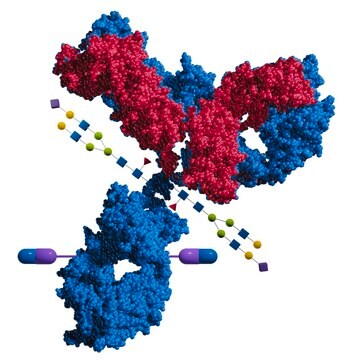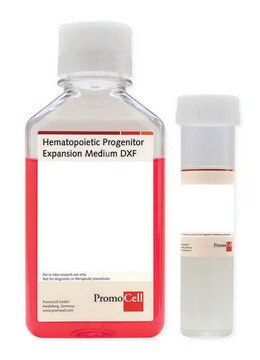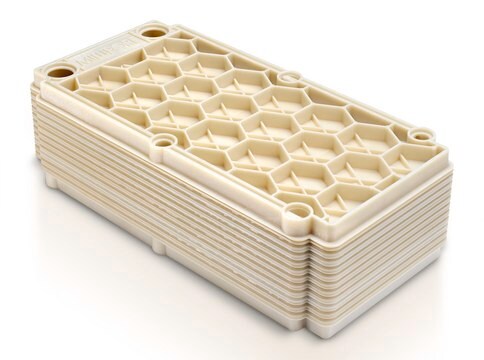MABC530
Anti-CEP Antibody, clone Das-1 (7E12H12)
clone 7E12H12, from mouse
Synonyme(s) :
Colon epithelial protein, CEP, Das-1 protein
About This Item
Produits recommandés
Source biologique
mouse
Niveau de qualité
Forme d'anticorps
affinity purified immunoglobulin
Type de produit anticorps
primary antibodies
Clone
7E12H12, monoclonal
Espèces réactives
human
Technique(s)
ELISA: suitable
dot blot: suitable
immunohistochemistry: suitable (paraffin)
immunoprecipitation (IP): suitable
western blot: suitable
Isotype
IgMκ
Conditions d'expédition
wet ice
Modification post-traductionnelle de la cible
unmodified
Description générale
Spécificité
Immunogène
Application
Western Blotting Analysis: A representative lot detected elevated CEP (colon epithial specific protein) levels among intraductal papillary mucinous neoplasm (IPMN) patients samples with high-risk/malignant lesions (Das, K.K., et al. (2014). Gut. 63(10):1626-1634).
Western Blotting Analysis: A representative lot detected CEP in colon adenocarcinoma cell line LS180 and in isolated colon epithelial cells, as well as in LS-180 culture supernatant, but not in normal jejunal epithelial cells (Kesari, K.V., et al. (1999). Clin. Exp. Immunol. 118(2):219-227).
Immunoprecipitation Analysis: A representative lot co-immuoprecipitated tropomyosin 5 with CEP from the culture supernatant of human adenocarcinoma cell line LS180 (Kesari, K.V., et al. (1999). Clin. Exp. Immunol. 118(2):219-227).
ELISA Analysis: A representative lot was used as the capture antibody in combination with the isotype switched mAb Das-1 IgG as the detection antibody using purified CEP and cyst fluid samples from Intraductal papillary mucinous neoplasm (IPMN) patients (Das, K.K., et al. (2014). Gut. 63(10):1626-1634).
Immunohistochemistry Analysis: A representative lot detected significantly higher CEP (colon epithial specific protein) immunoreactivity among intraductal papillary mucinous neoplasm (IPMN) patients samples with high-risk/malignant lesions (Das, K.K., et al. (2014). Gut. 63(10):1626-1634).
Immunohistochemistry Analysis: Representative lots detected CEP (colon epithial specific protein) immunoreactivity by both fluorescent and non-fluorescent immunhistochemistry in colonic, but not small intestinal, enterocytes using both frozen and formalin-fixed, paraffin-embedded tissue sections (Moriichi, K., et al. (2009). Int. J. Cancer. 124(6):1263-1269; Piazuelo, M.B., et al. (2004). Mod. Pathol. 17(1):62-74; MIrza, Z.K., et al. (2003). Gut. 52(6):807-812; Glickman, (2001). J.N., et al. Am J Surg Pathol. 25(1):87-94; Griffel, L.H., et al. (2000). Dig. Dis. Sci. 45(1):40-48; Hamilton, M.I., et al. (1995). Clin. Exp. Immunol. 99(3):404-411; Halstensen, T. S., et al. (1993). Gut. 34(5):650-657; Das, K.M., et al. (1987). J. Immunol. Vol. 139(1):77-84).
Dot Blot Analysis: A representative lot detected CEP immunoreactivity in colon protein extracts (Hamilton, M.I., et al. (1995). Clin. Exp. Immunol. 99(3):404-411).
Qualité
Immunohistochemistry Analysis: A 1:1,000 dilution of this antibody detected CEP in human colon tissue.
Description de la cible
Forme physique
Autres remarques
Vous ne trouvez pas le bon produit ?
Essayez notre Outil de sélection de produits.
Code de la classe de stockage
10 - Combustible liquids
Classe de danger pour l'eau (WGK)
WGK 2
Point d'éclair (°F)
Not applicable
Point d'éclair (°C)
Not applicable
Certificats d'analyse (COA)
Recherchez un Certificats d'analyse (COA) en saisissant le numéro de lot du produit. Les numéros de lot figurent sur l'étiquette du produit après les mots "Lot" ou "Batch".
Déjà en possession de ce produit ?
Retrouvez la documentation relative aux produits que vous avez récemment achetés dans la Bibliothèque de documents.
Notre équipe de scientifiques dispose d'une expérience dans tous les secteurs de la recherche, notamment en sciences de la vie, science des matériaux, synthèse chimique, chromatographie, analyse et dans de nombreux autres domaines..
Contacter notre Service technique







